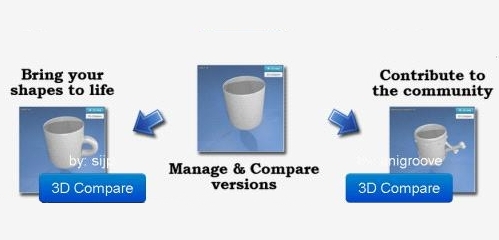Both articles by yours truly on 3DPI today point to the ever-increasing number of 3D file repositories. But while the other one, which provides an overview of Threeding, poses the question: ‘Unfortunately, not everyone is an artist and designer, and not every object could be designed on a computer, so people have to buy some of the items they would like to print. What a better place to find different things than a marketplace?’ this one — ShapeDo — seems to answer that question effectively.
ShapeDo brings us a GitHub style approach to 3D files. GitHub, for the 3DPI reader who is only slightly geeky, is the most popular programming code repository site for open source projects. One of GitHub’s most memorable features is Forking, creating a clone of an open source code stored on the site and a new branch of progress for it. Sharing is the name of the game and profit seeking is not compulsory.
ShapeDo possesses a strong suite of features: a 3D file repository, code repository, 3D editing tools, live information on the print considerations (volume of filament required, etc.), social media sharing and comments, correct copyright attribution such as open source or Creative Commons, … and much more. The all-in-one approach is impressive.
A race to the bottom for production costs by low-to-middleweight 3D designers looks likely if this emerging disruptive technology sector follows at least some predictable cycles, but in turn, as the ‘cheapest tier’ of 3D files are free it may be interesting to see how many months or years it will take for the majority of variations on 3D printable forms to appear on 3D file repositories. For websites with an open-source element already this will be no problem, as ultimately it is the millions of slight variations upon hundreds of thousands of open designs that may be a key disruptive feature of 3D printing.
Despite the counter-reaction to the reactionary mass media hype over 3D printing in the past year, the average computer user can garner a basic functional understanding of 2D photo-editing software in a single session. It seems unlikely therefore, that basic changes to 3D files such as scaling will remain out of the hands of the CAD illiterate majority forever. Yes people want easy; no most people do not have time to craft their own designs, but creating a design, and making dimensional amendments to a design are a long way apart… load it onscreen, 1.5 x the size, blue and red, ‘3D print.’
A wide range of free files that can be edited freely, and easily (i.e. touch screen gestures, sliding bars for scale, skew, etc.) may provide the widest utility for the least expense to the most amount of people. Where utility, cost efficiency and ease-of-use meet, winners are found. Utility is what will draw users to ShapeDo.
In time, ‘lower quality’ designers are going to be working for accolades and gravitas via accreditation more than financial rewards — those ‘lower quality’ designers may include anyone and everyone however, as the whole water table of 3D CAD skills rises in society. Free access to free designs is another thing that will draw users to ShapeDo.
Ultimately, a range of paid original products, closed-source free samples, barter-orientated free open-source printables and what this author at least has decided to call repairables (replacement parts for existing objects) are some of the emerging strata of what may be collectively called 3D-printables. Repositories and marketplaces that can fulfill as many stratas and features as possible stand the best chance of still being extant this time next year. Given ShapeDo’s feature-laden potential it should do well, squaring up to competitors with its breadth of features and depth of potential of community driven design.
Ari Isaacs, CEO and a founder at ShapeDo said: “What really got me into the maker community is the way everyone works together. There is no competition: curious brilliant people hang out and build stuff. Because we want to hack the world, because robots and 3D printers are awesome, and open-source robots are even better. That is exactly how we built ShapeDo – A place where everyone is working together to build stuff.”



